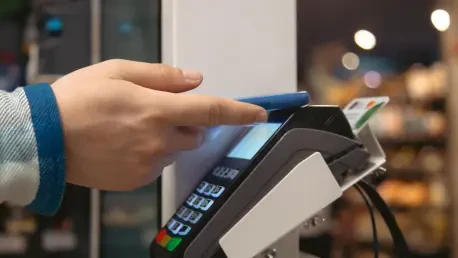Imagine a bustling retail store where checkouts are instantaneous, inventory updates in real-time across online and offline channels, and store associates personalize every customer interaction with data at their fingertips. This is no longer a distant vision but a reality shaped by modern point of sale (POS) systems. As retail continues to grapple with the convergence of physical and digital commerce, these systems have emerged as indispensable tools, transforming transactional endpoints into strategic hubs. This review delves into the cutting-edge world of POS technology, exploring how these innovations are redefining operational efficiency and customer engagement in an ever-evolving industry.
Evolution and Core Functionalities of Modern POS Systems
POS systems have undergone a remarkable transformation from simple cash registers to sophisticated platforms that integrate multiple facets of retail operations. Initially designed for basic transaction processing, today’s solutions encompass a wide array of functionalities, including payment processing, inventory management, and customer relationship tools. This evolution reflects a broader shift in retail toward unified commerce, where seamless connections between in-store and online experiences are paramount. The ability to process transactions swiftly while capturing valuable data has positioned these systems as central to retail strategy.
At the heart of modern POS systems lie core components such as cloud-based architectures and integration with digital platforms. These systems enable real-time data processing, ensuring that inventory levels, sales metrics, and customer preferences are instantly accessible across channels. This capability not only streamlines operations but also empowers retailers to make informed decisions on the fly. As the retail landscape continues to demand agility, the role of POS technology in bridging physical and digital touchpoints cannot be overstated.
The significance of these systems extends beyond mere functionality to enhancing overall customer experiences. By providing store associates with actionable insights, POS solutions facilitate personalized interactions that build loyalty. Moreover, their integration with other retail technologies, such as e-commerce platforms and mobile apps, creates a cohesive ecosystem that addresses the complexities of modern shopping behaviors. This interconnectedness underscores their importance in driving both efficiency and satisfaction in retail environments.
Key Features Driving POS Innovation
Unified Commerce Integration
One of the standout features of cutting-edge POS systems is their ability to integrate online and offline channels, creating a seamless shopping experience. This unified commerce approach ensures that customers can start their journey online and complete it in-store—or vice versa—without encountering friction. Solutions like Manhattan Active® Point of Sale exemplify this by acting as a central hub that synchronizes data across enterprise-scale operations, enabling consistent service regardless of the touchpoint.
The performance of unified commerce integration directly impacts omnichannel retail strategies. Retailers can now manage inventory, process returns, and track customer interactions across all platforms from a single interface. This not only reduces operational silos but also enhances the ability to meet customer expectations for flexibility. As shopping habits continue to blur the lines between digital and physical spaces, this feature remains a cornerstone of competitive advantage.
Real-Time Data and Inventory Visibility
Another critical feature is the provision of real-time data and inventory visibility, which accelerates checkouts and supports dynamic fulfillment options. Systems such as GK Software’s OmniPOS and KWI POS leverage this capability to provide endless aisle selling, where customers can access products beyond in-store stock through immediate online ordering. This responsiveness transforms the shopping experience by eliminating delays and stockouts.
The operational benefits of real-time data extend to optimizing internal processes as well. Retailers gain instant insights into sales trends, allowing for rapid adjustments to stock levels or pricing strategies. For instance, associates using these systems can quickly identify high-demand items and suggest alternatives during customer interactions, thereby improving service quality. This feature proves essential in maintaining agility in a fast-paced retail environment.
Recent Advancements in POS Technology
The latest advancements in POS systems highlight a shift toward cloud-based architectures that offer scalability and flexibility. These platforms allow retailers to adapt quickly to changing demands without the burden of extensive hardware upgrades. Coupled with modular designs, such systems enable businesses to tailor functionalities to specific needs, ensuring relevance across diverse retail formats.
Emerging trends also include AI-driven features that enhance personalization through clienteling, where associates use data to offer tailored recommendations. Additionally, the rise of industry-specific solutions caters to unique sector challenges, such as compliance in regulated markets or workflow optimization in hospitality. These innovations reflect a deeper understanding of varied retail requirements and a commitment to addressing them with precision.
Consumer behavior shifts, particularly the surge in digital payments, continue to influence POS development. The demand for contactless transactions has spurred the integration of advanced payment processing capabilities, ensuring compatibility with mobile wallets and other modern methods. This adaptability to payment trends demonstrates how POS technology remains attuned to evolving market dynamics, prioritizing convenience and security.
Real-World Applications Across Retail Sectors
POS systems are deployed across a spectrum of retail sectors, showcasing their versatility from large-scale operations to niche markets. In the food service industry, Toast POS streamlines order management and guest engagement with AI-driven tools like ToastIQ, which personalizes service while optimizing staff workflows. Such targeted applications highlight the technology’s ability to address specific operational pain points.
In regulated industries like cannabis, POSaBIT stands out by integrating compliance features such as ID verification and tax reporting directly into the checkout process. Meanwhile, Salesfloor POS focuses on customer engagement in retail by enabling remote selling and video chat interactions, transforming how associates connect with shoppers. These examples illustrate the diverse ways POS systems adapt to unique industry demands.
Unique use cases further emphasize the flexibility of modern POS solutions. Mobile-first workflows allow associates to assist customers anywhere in the store, breaking free from fixed checkout counters. Remote selling capabilities also enable transactions beyond physical locations, catering to a growing preference for convenience. This adaptability ensures that POS technology remains relevant across varied retail contexts.
Challenges in Adoption and Implementation
Despite their benefits, adopting innovative POS systems comes with significant challenges, particularly in integrating with legacy infrastructure. Many retailers still rely on outdated systems that are incompatible with modern cloud-based solutions, leading to costly and complex transitions. This barrier often delays the realization of full operational benefits and requires careful planning to mitigate disruptions.
Technical hurdles also persist, especially concerning data security in cloud environments. Protecting sensitive customer and transaction information against breaches is a top priority, yet it remains a concern for many businesses. Additionally, scalability issues affect small to medium-sized retailers who may struggle with the costs and resources needed to implement advanced systems, limiting their access to cutting-edge tools.
Efforts to address these limitations are ongoing, with developers offering continuous software updates to enhance compatibility and security. Customizable solutions also help tailor POS systems to specific business sizes and needs, reducing adoption friction. While challenges remain, these initiatives signal a commitment to making POS technology accessible and effective for a broader range of retailers.
Future Outlook for POS Development
Looking ahead, the trajectory of POS technology points toward deeper integration of AI and machine learning to refine customer insights and operational predictions. These advancements promise to elevate personalization by analyzing vast datasets for more accurate recommendations and inventory planning. Such capabilities could redefine how retailers anticipate and respond to consumer needs.
Anticipated breakthroughs include broader adoption of contactless payment solutions to meet ongoing demand for speed and safety. Enhanced omnichannel integration will likely further blur the lines between online and offline experiences, creating even more cohesive customer journeys. As these developments unfold, POS systems are poised to become the central nervous system of unified commerce, orchestrating all facets of retail interaction.
The long-term impact of POS technology on retail will likely center on its role in driving strategic agility. By serving as a backbone for data-driven decision-making, these systems will enable retailers to stay ahead of market trends and customer expectations. Their evolution will continue to shape a retail landscape that prioritizes seamless connectivity and tailored experiences over traditional transactional models.
Final Thoughts on POS Innovation
Reflecting on this exploration, it becomes evident that innovative POS systems have reshaped retail technology by addressing critical challenges of efficiency and engagement. Their ability to unify commerce channels, deliver real-time insights, and adapt to diverse industry needs marks a significant leap forward in how businesses operate. This review highlights their transformative power in creating seamless customer experiences.
Moving forward, retailers should prioritize assessing their current systems against these advanced solutions to identify gaps and opportunities for improvement. Investing in scalable, cloud-based POS platforms could provide the flexibility needed to navigate future market shifts. Additionally, staying informed about emerging features like AI-driven personalization will be crucial for maintaining a competitive edge.
As the retail sector continues to evolve, collaboration between technology providers and businesses will be key to overcoming adoption barriers. Exploring pilot programs or phased implementations could ease transitions for those hesitant about full-scale upgrades. Ultimately, embracing these innovations offers a pathway to sustained growth and resilience in a dynamic industry.








